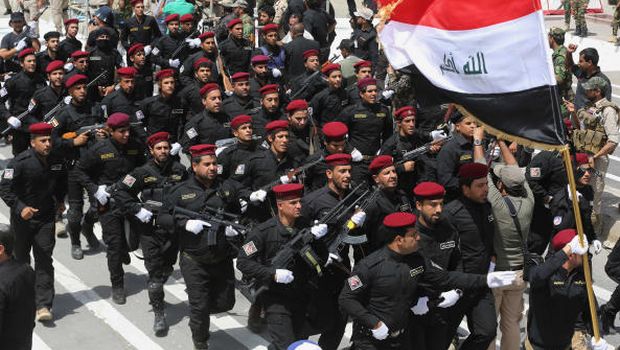
Volunteers for the newly formed “Peace Brigades” participate in a parade in the Shi’ite stronghold of Sadr City, Baghdad, Iraq, on Saturday, June 21, 2014. (AP Photo/Karim Kadim)
Baghdad, Asharq Al-Awsat—A prominent Shi’ite movement in Iraq has defended a military parade it organized in the country’s capital Baghdad on Saturday amid heightened fears of widespread sectarian conflict breaking out across the country.
The event, organized by the Sadrist Movement, showed off heavy weapons such the ‘Moqtada 1,’ a missile named after the movement’s leader Moqtada Al-Sadr, and comes as the Sunni jihadist group the Islamic State of Iraq and Syria (ISIS) continues its advance from western and northern regions in Iraq towards Baghdad.
In a statement on Sunday, Sadr thanked the participants in the parade and slammed satellite TV stations, particularly Shi’a ones, for “ignoring the parade.” He stressed that the Peace Brigades—the new armed group he has asked to be formed in order to fight the ISIS advance—should not be given any “sectarian denomination.”
Sadr was the leader of another armed Shi’a militia group, the Mahdi Army, which he suspended in 2012, and which was prominent during the sectarian conflicts that exploded in the country in 2006–2008.
The Iraqi government has not commented on the paraded weapons, which observers said included missiles and artillery that could only belong to an official army.
A senior Sadrist figure denied the weapons were taken from the Iraqi army. “Most of the weapons displayed during the parade of the Peace Brigades belong to the Promised Day Brigade which was exempted by Sadr from suspension when he decided to suspend the Mahdi Army,” Mohammed Al-Khafaji, a senior figure in the Sadrist Movement, told Asharq Al-Awsat.
He said that the Promised Day Brigade was “one of the most prominent arms of resistance against the American occupation of Iraq and managed to collect many of the weapons left by the Americans, which became spoils of war,” adding that the Brigade “has the right to use” these weapons.
“Some of the weapons were made in Baghdad, as the Promised Day Brigade has an infrastructure which it built during its resistance of the [US-led] occupation. And today we are seeing the dangers starting to surround Iraq anew, and this obliges us to defend again the land, [its] honor, religion and doctrine,” Khafaji added, referring to ISIS’s threats to destroy Shi’a shrines and holy places.
He added: “Taking on this mission is therefore one of the factors that will help prevent the eruption of a civil war, and this is the responsibility of Sunnis as much as it is the responsibility of Shi’ites.”
Speaking about fears that such weapons would be used in any domestic conflict, Khafaji said: “All Iraqis, Sunnis and Shi’ites, are now facing a common enemy which is ISIS and the terrorist organizations, which are not associated with a religion or a sect.
He added: “Our Sunni brothers are fighting these gangs in their areas.”
Khafaji sought to calm fears regarding the Peace Brigades and said that Sadr’s instructions were for them to “coordinate with the [official Iraqi] security apparatuses, according to the relevant directives issued by the [Shi’ite religious] authority.”
The Sadrist Movement’s defense of the parade has come despite a number of Shi’ite religious leaders recently calling for weapons-possession to remain limited to authority of the state and its security apparatuses, and not with civilians.
Meanwhile, a number of news websites have circulated photographs of Ismail Hafez al-Lami—known as “Abu Deraa”—a militant leader accused of committing atrocities against Sunnis, and known as “the Zarqawi of the Shi’ites,” in reference to the leader of Al-Qaeda in Iraq Abu Musab Al-Zarqawi.
Abu Deraa was seen and photographed on Saturday during a parade in Baghdad’s Sadr City, staged as a show of force in response to the ISIS advance.
Speaking to Asharq Al-Awsat on condition of anonymity, an Iraqi security source said that “the Abu Deraa issue” had been “blown out of proportion,” saying it was used during the period 2006–2008 as part of the tug-of-war between Al-Qaeda on the Sunni side and the then Mahdi Army on the Shi’ite side.
The source added: “There are strict instructions now, particularly from the Shi’ite religious leaders, not to get bogged down in any such issues because the situation in the country no longer brooks this, and any sectarian escalation in the light of what is happening, given the underperformance of the military institution, will mean serious consequences for those who adopt or promote such ideas.”
